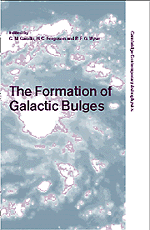Book contents
- Frontmatter
- Contents
- Preface
- Dedication: In Memory of Olin Eggen
- Part 1 Introduction
- Part 2 The Epoch of Bulge Formation
- Part 3 The Timescales of Bulge Formation
- Constraints on the Bulge Formation Timescale from Stellar Populations
- Bulge Building with Mergers and Winds
- Role of Winds, Starbursts, and Activity in Bulge Formation
- Dynamical Timescales of Bulge Formation
- Part 4 Physical Processes in Bulge Formation
- Part 5 Bulge Phenomenology
- Part 6 Conference Summary
- Index
Constraints on the Bulge Formation Timescale from Stellar Populations
from Part 3 - The Timescales of Bulge Formation
Published online by Cambridge University Press: 10 November 2010
- Frontmatter
- Contents
- Preface
- Dedication: In Memory of Olin Eggen
- Part 1 Introduction
- Part 2 The Epoch of Bulge Formation
- Part 3 The Timescales of Bulge Formation
- Constraints on the Bulge Formation Timescale from Stellar Populations
- Bulge Building with Mergers and Winds
- Role of Winds, Starbursts, and Activity in Bulge Formation
- Dynamical Timescales of Bulge Formation
- Part 4 Physical Processes in Bulge Formation
- Part 5 Bulge Phenomenology
- Part 6 Conference Summary
- Index
Summary
Within recent years, there has been a confluence of data that favors a large age for the bulges of the Milky Way and M31. A short formation timescale is required by the similarity in ages between the bulge and the old, metal-rich globular clusters. Detailed abundances of bulge giants are consistent with a short enrichment timescale. The bulge of M31 is similarly old and even more metal-rich than the Galactic bulge. There appears to be a strong connection between the M31 bulge and the halo, as metal-rich giants are found in M31 out to great distances. The stellar populations data support a rapid bulge formation timescale, perhaps even less than 1 Gyr.
Introduction
“We must conclude, then, that in the central region of the Andromeda Nebula we have a metal-poor Population II, which reaches −3m for the brightest stars, and that underlying it there is a very much denser sheet of old stars, probably something like those in M67 or NGC 6752. We can be certain that these are enriched stars, because the cyanogen bands are strong, and so the metal/hydrogen ration is very much closer to what we observe in the Sun and in the present interstellar medium than to what is obwserved for Population II. And the process of enrichment probably has taken very little time. After the first generation of stars has formed, we can hardly speak of a ‘generation’, because the enrichment takes place so soon, and there is probably very little time difference.
- Type
- Chapter
- Information
- The Formation of Galactic Bulges , pp. 54 - 63Publisher: Cambridge University PressPrint publication year: 2000

